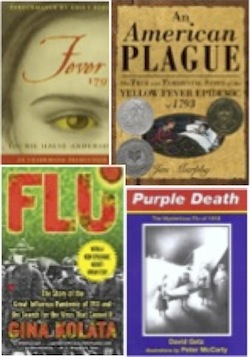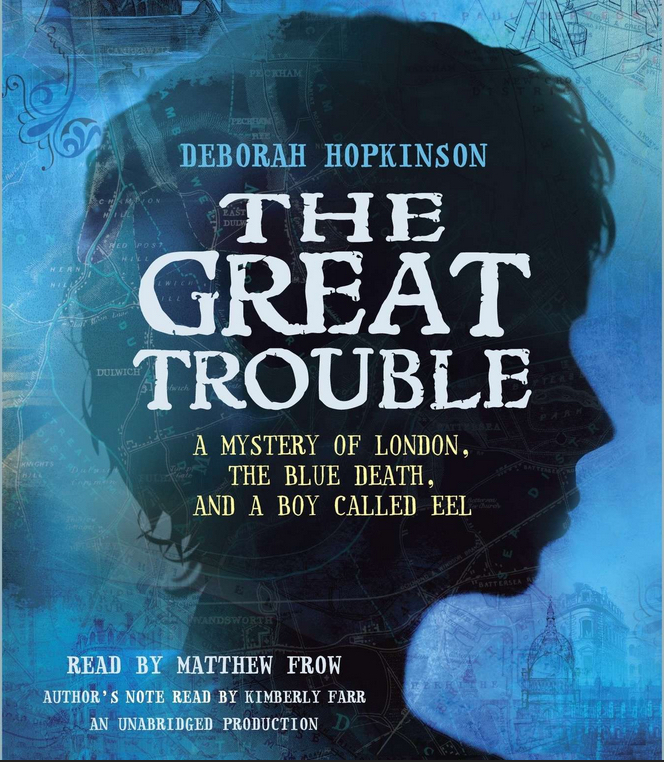by T. Gail Pritchard, PhD, College of Medicine, University of Arizona
 This week, the focus will be on specific pandemic, epidemic, and outbreak historical events captured in picture books and chapter books. Frischknect, Lepper, and Cyrklaff (2008) note, “infectious diseases have played a substantial part in shaping the history of humanity” (p. 995) and “it is often an issue of wrong information” (p. 996). Further, they state, “The dramatic effects of lacking information can be seen in many historical contexts, e.g. the spread of the Plague in medieval Europe, the accidental import of smallpox and measles into the Americas, the deliberate release of infectious agents, or the recent spread of HIV in much of Africa” (Frischknecht, p. 997). The books reviewed this week demonstrate exactly that—the role of infectious diseases in shaping global history.
This week, the focus will be on specific pandemic, epidemic, and outbreak historical events captured in picture books and chapter books. Frischknect, Lepper, and Cyrklaff (2008) note, “infectious diseases have played a substantial part in shaping the history of humanity” (p. 995) and “it is often an issue of wrong information” (p. 996). Further, they state, “The dramatic effects of lacking information can be seen in many historical contexts, e.g. the spread of the Plague in medieval Europe, the accidental import of smallpox and measles into the Americas, the deliberate release of infectious agents, or the recent spread of HIV in much of Africa” (Frischknecht, p. 997). The books reviewed this week demonstrate exactly that—the role of infectious diseases in shaping global history.
Yellow Fever
According to the Oxford Handbook of Tropical Medicine (Eddleston, Davidson, Brent, & Wilkinson, 2008), regarding Yellow Fever (YF), “there are -200,000 cases/year and >30,000 deaths. YF occurs mainly in sub-Sahara Africa; there are far fewer cases in tropical South American and YF does not occur in Asia…. Humans may be accidentally infected when they are bitten by an infected mosquito. The disease may then be spread by mosquitoes from infected human to susceptive human, causing explosive epidemics in urban environments” (p. 728.
Murphy, J. (2003). An American Plague: The True and Terrifying Story of the Yellow Fever Epidemic of 1793. Clarion Books. ISBN 10: 0395776082. 176 pp.
In this fascinating look at one of the most momentous epidemics in U.S. history, this non-fiction Newbery Honor Book delves into the impact of Yellow Fever in Philadelphia in 1793. Since YF does not occur in the U.S., how did it get here? Who did it affect? How was it stopped? What did we learn about outbreaks from this particular epidemic? Murphy chronicles the introduction of YF through riveting details in a highly readable book.
Anderson, L.H. (2002). Fever 1793. Simon & Schuster Books for Young Readers. ISBN 10: 9780689838583, 256 pp.
While Murphy’s book is a nonfiction account, Anderson’s telling is historical fiction. The narrator is Mattie, a young teenager, who finds herself caught up in the fear, misconceptions, and lack of understanding regarding the mysterious illness that is felling citizens of Philadelphia by the thousands. Coupled with the facts from Murphy’s book, readers gain a well-researched “insider’s” perspective during the crisis of YF in the United States.
Influenza
“Influenza viruses serogroups A, B, and C are RNA viruses that cause respiratory tract infections in humans. Influenza A can cause epidemic disease, and rarely can lead to a global pandemic” (Eddleston, Davidson, Brent, and Wilkinson, 2008. p. 716.” But that is exactly what happened in 1918—then known as Purple Death and now known as the Spanish Flu, this pandemic “resulted in unprecedented mortality, with an estimated 500,000-675,000 deaths in the U.S. and 50-100 million deaths worldwide” (Hatchett, Mecher, & Lipsitch, 2007, p. 7582).
Getz, D. (2000). Purple Death: The Mysterious Flu of 1918. Henry Holt and Co. ISBN 10: 080505751X. 96 pp.
When I first received this book in 2000, I immediately opened it and read it on the spot. I was fascinated with the topic. I then called my mother who was born in 1922 and who had three older siblings and a younger (1912, 1914, 1916, 1924), and I asked her if she had ever heard of this flu pandemic; her reply, “Oh, yes. I grew up hearing stories about this outbreak.” I was so surprised she had never said anything about it, because I heard lots of stories about polio—both of her older brothers were stricken with polio. But, then she went on to say, “My family was lucky, no one got really sick.” So I suspect that is why she never said anything about it. The fact, though, is that millions got sick and died and many of those were young soldiers in camps across the U.S. One of the confounding questions of this pandemic is, “Why the young and healthy?” Scientists have been unable to answer this as well as its origin—it came in quickly, burned through the populations quickly, and it disappeared quickly.
Kolata, G. (2001). Flu: The Story of the Great Influenza Pandemic. Touchstone. ISBN 10: 0743203984. 352 pp.
Kolata, a science writer for the New York Times, meticulously tracks the influenza pandemic that created global devastation from 1918-1920. Throughout her detailed account of this often overlooked crisis in history, Kolata tells of scientists examining remains to genetically map this virus and applying what was learned to modern-day scenarios of outbreaks such as the swine flu and H1N1 virus.
Last week, I began September’s Blog with a review of books related to pandemics, epidemics, and outbreaks in general. Ironically, in our university email this past week was an announcement for “Pandemic Flu: An Exercise in Disaster Preparedness,” a simulation including our campus and two other campuses in our state. In this simulation exercise, participants will “be exposed to some of the threats and consequences of public health emergencies…” and includes discussions from the Surgeon General and the former Director for the Coordinating Office of Terrorism Preparedness and Emergency Response at the Centers for Disease Control. Clearly, this is an issue at the state and federal levels…. As we move toward next week’s blog, I’ll be thinking about books that deal with those infectious diseases which haven’t yet occurred and what happens then…
Related Reads
AIDS/HIV
 Ballard, C. (2009). AIDS and Other Epidemics (What if We Do Nothing?). Gareth Stevens Publishing.
Ballard, C. (2009). AIDS and Other Epidemics (What if We Do Nothing?). Gareth Stevens Publishing.
Ellis, D. (2004). The Heave Shop. Fitzhenry and Whiteside. 186 pp.
Flinn, A. (2005). Fade to Black. Harper Teen. 192 pp.
Stratton, A. (2004). Chanda’s Secrets. Annick Press. 200 pp.
Cholera
 Berten, J.P. (2003). Littsie of Cincinnati. Fountain Square Publishing, LLC. 125 pp.
Berten, J.P. (2003). Littsie of Cincinnati. Fountain Square Publishing, LLC. 125 pp.
Brown, D. (2006). The Notorious Izzy Fink. Roaring Book Press. 150 pp.
Hopkinson, D. (2013). The Great Trouble: A Mystery of London, the Blue Death, and a Boy Called Eel. Alfred A. Knop Books for Young Readers. 256 pp.
Typhoid
Chibbaro, J. (2011). Deadly. Atheneum. 304 pp.
Dahem, J. (2010). Contagion. Running Press Kids. 400 pp.
Hesse, K. (2009). Letters from Rifka. Square Fish. 176 pp.
Additional Resources
Crosby, M.C. (2007). The American Plague. Berkley Trade. 384 pp.
Farrell, J. (2005). Invisible Enemies, Revised Edition: Stories of Infectious Disease. Farrar, Straus, and Giroux. 272 pp.
Friedlander, M. P. (2009). Outbreak: Disease Detectives at Work. Twenty-First Century. 128 pp.
Hess, K. (1997). A Time of Angels. Disney-Hyperion. 256 pp.
Jurmain, S. (2013). Secret of the Yellow Death: A True Story of Medical Sleuthing. HMH Books for Young Readers. 112 pp.
Keith, J. (2012). Fever Season: The Story of a Terrifying Epidemic and the People Who Saved a City. Bloomsbury Press. 272 pp.
Moss, J. (2009). Winnie’s War. Walker. 192 pp.
Myers, A. (1995). Graveyard Girl. Walker. 128 pp.
Stern, E.N. (2001). The French Physician’s Boy: A Story of Philadelphia’s 1793 Yellow Fever Epidemic. Xlibris Corp. 128 pp.
Walker, R. (2006). Epidemics & Plagues. Kingfisher Knowledge. 63 pp.
Ward, B. (2000). Epidemic. DK Children. 64 pp.
Williams, S.D. (). Palace Beautiful. Puffin. 240 pp.
Winters, C. (2013). In the Shadow of Blackbirds. Amulet Books. 400 pp.
References
Eddleston, M., Davidson, R., Brent, A., and Wilkinson. (2008). Oxford Handbook of Tropical Medicine. Oxford University Press.
Frischknecht, F., Lepper, S., and Cyrklaff, M. (2008). Meeting Report: How to get wrong things right—a discussion over current and future pandemic infectious diseases. Biotechnol Journal, 3, 995-998.
Hatchett, R.J., Mecher, C.E., and Lipsitch, M. (2007). Public health interventions and epidemic intensity during the 1918 influenza pandemic. Proceeding of the National Academy of Sciences, 104(18), pp. 7582-7587.
Journey through Worlds of Words during our open reading hours: Monday-Friday, 9 a.m. to 5 p.m. and Saturday, 9 a.m. to 1 p.m. To view our complete offerings of WOW Currents, please visit archival stream.
- Themes: T. Gail Pritchard
- Descriptors: Books & Resources, WOW Currents
